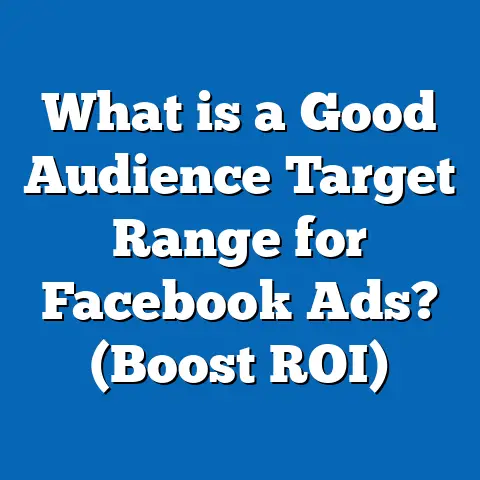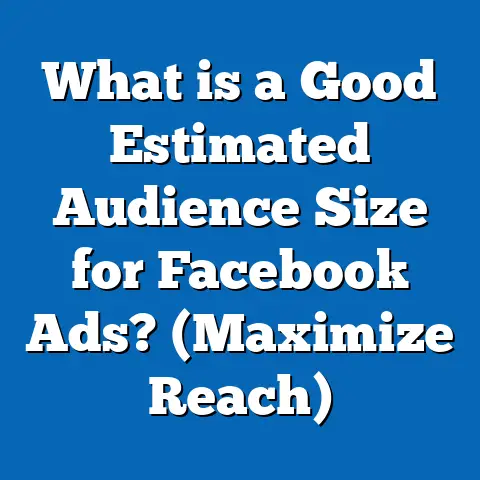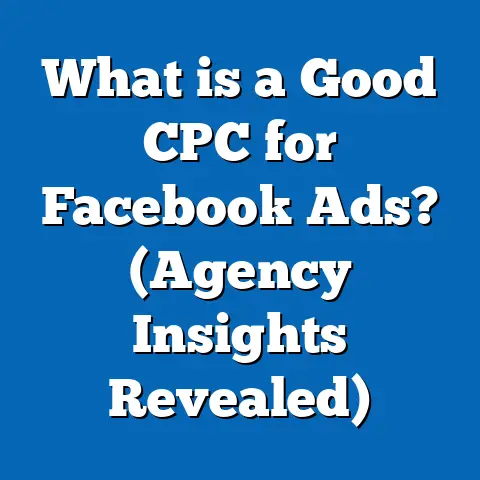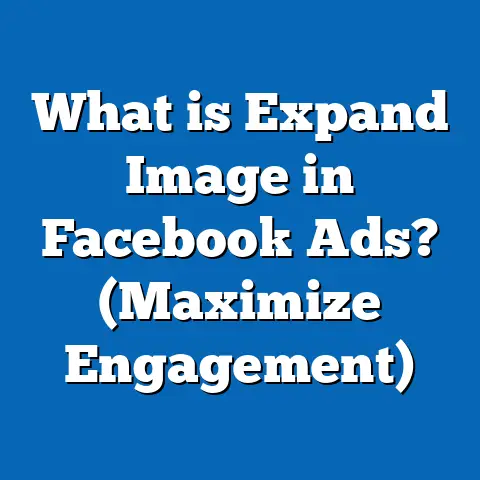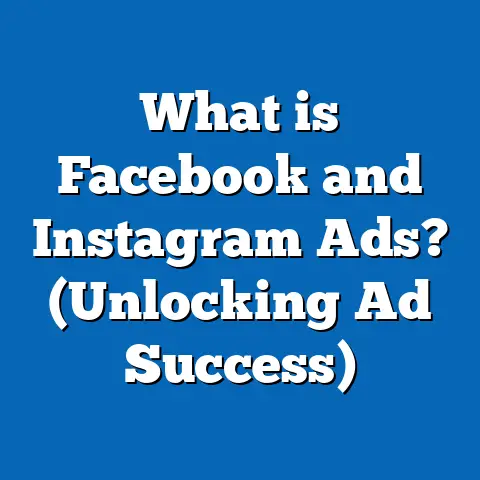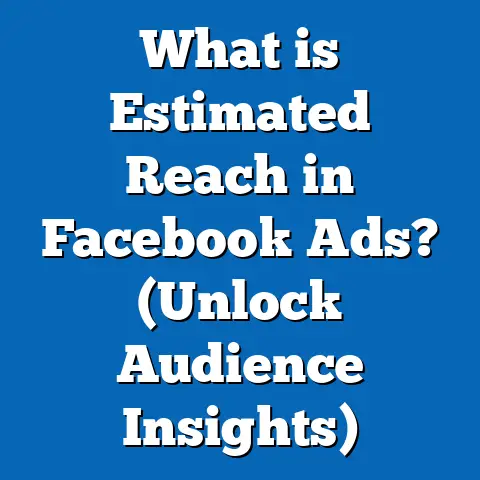What is a Dynamic Ad on Facebook? (Unlocking Ad Personalization)
What is a Dynamic Ad on Facebook? (Unlocking Ad Personalization)
Introduction: Imagine a Tailor-Made Suit for Every Customer
Picture walking into a clothing store where every suit is designed exactly to your measurements, style preferences, and color choices. You don’t need to waste time sorting through racks hoping to find the right fit. Instead, the store presents suits tailored just for you.
This is the core idea behind Facebook’s dynamic ads—a way to deliver personalized advertisements automatically tailored to each user’s browsing behavior, preferences, and interactions. In the crowded digital marketplace, where consumers are bombarded with generic ads daily, personalization is the key to winning attention and driving conversions.
Dynamic ads help marketers present the right products to the right people at the right time. This approach not only enhances user experience but also drives business outcomes by reducing wasted ad spend and improving engagement rates. Let’s explore how dynamic ads work, why they matter, and how you can use them effectively.
Understanding Dynamic Ads on Facebook
What Are Dynamic Ads?
Dynamic ads are a form of personalized advertising where the ad creative and content dynamically change based on user behavior and product data. Unlike traditional ads that feature fixed images or messages for everyone, dynamic ads automatically generate individual ad creatives using product feeds combined with audience data.
This means if a potential customer browses your website or app but leaves without buying, Facebook can show them ads featuring exactly the products they viewed or related items. This level of personalization helps recapture their interest and encourages them to complete a purchase.
The Difference Between Static Ads and Dynamic Ads
| Feature | Static Ads | Dynamic Ads |
|---|---|---|
| Creative Content | Fixed images/videos | Automatically generated from product catalog |
| Personalization | One-size-fits-all | Customized per user based on behavior |
| Setup Effort | Manual creation per ad | Automated once product catalog is set |
| Best Use Cases | Brand awareness, simple offers | Retargeting, cross-selling, prospecting |
| Conversion Efficiency | Moderate | High |
Dynamic ads reduce repetitive manual work for advertisers while improving relevance and performance.
How Do Facebook Dynamic Ads Work?
Facebook’s dynamic ads rely on three core components:
1. Product Catalog
A product catalog is a structured database containing detailed information about every item you want to advertise. It includes:
- Product IDs
- Titles
- Descriptions
- Prices
- Images
- URLs
- Availability status
This catalog is uploaded or connected via platforms like Shopify or Magento and updated regularly.
2. Facebook Pixel and SDK
The Facebook Pixel tracks visitor actions on your website such as product views, adding items to cart, and purchases. For mobile apps, the Facebook SDK tracks similar events within the app environment.
This tracking data allows Facebook to understand user preferences and behaviors in real-time.
3. Automated Ad Creation and Delivery
Using the catalog and behavioral data from Pixel/SDK, Facebook automatically generates ads tailored to each user’s interests. These ads are then shown to users most likely to convert based on their past interactions.
Why Are Dynamic Ads Important? Data-Backed Insights
Enhanced User Experience Drives Results
Personalized ads provide users with relevant product recommendations rather than generic pitches. This improves engagement and creates a better shopping experience.
Key Statistics Supporting Dynamic Ads Effectiveness
- 50% higher click-through rates (CTR): Advertisers report that dynamic ads outperform static ads by delivering more relevant content.[1]
- 30-40% increase in conversion rates: Retargeting users with dynamic ads leads to significantly higher purchase completions.[2]
- 20-35% lower cost per acquisition (CPA): Targeted ads reduce wasted spend by focusing only on interested users.[3]
Real-World Benefits for Businesses
- Improved ROI: Higher conversions at lower costs mean better returns.
- Scalability: Automated ad generation lets businesses promote thousands of products without manual setup.
- Customer Retention: Dynamic ads can foster repeat purchases by showing complementary products or upgrades.
The Technical Framework Behind Facebook Dynamic Ads
Product Catalog: The Heart of Your Campaign
Your product catalog should be clean and comprehensive. Common formats include CSV files or direct connections to eCommerce platforms.
Key tips for catalog management:
- Use unique product IDs consistently.
- Ensure all required fields are complete (images, prices, URLs).
- Update inventory regularly to avoid advertising out-of-stock products.
- Include custom labels for better segmentation (e.g., “New Arrival,” “Best Seller”).
Pixel and SDK: Tracking User Behavior
The Facebook Pixel is a small snippet of JavaScript code added to your website. It tracks specific events critical for dynamic ads:
- ViewContent: When a user views a product page.
- AddToCart: When a product is added to the shopping cart.
- InitiateCheckout: When checkout starts.
- Purchase: When a transaction completes.
For mobile apps, the Facebook SDK tracks similar events inside the app interface.
These detailed events enable Facebook’s algorithm to identify user intent and target ads accordingly.
Ad Set and Campaign Configuration
In Ads Manager:
- Select “Catalog Sales” as the campaign objective.
- Define your audience using pixel data (website visitors, cart abandoners) or broader targeting.
- Choose the product set from your catalog to feature.
- Set budget and bidding strategy aligned with campaign goals.
Creative Templates: How Ads Are Generated Dynamically
Ad templates contain placeholders like:
- {{product.name}}
- {{product.image_url}}
- {{product.price}}
Facebook replaces these placeholders with actual product info from your catalog when serving the ad. This automation saves time while ensuring consistency.
Types of Facebook Dynamic Ads and Their Applications
1. Retargeting Ads
These are the most common use case. Users who visit your website or app but don’t convert get shown ads reminding them of products they viewed.
Example: A visitor browses men’s watches but leaves without buying. Later, they see dynamic ads featuring those exact watches with special discounts.
2. Broad Audience Prospecting
Dynamic ads can also be used to reach new users who haven’t interacted with your brand yet by showing popular or trending products tailored to their interests.
Example: An outdoor gear brand targets hiking enthusiasts by showing their bestselling tents and backpacks dynamically.
3. Cross-Selling and Up-Selling
Once someone buys a product, dynamic ads can show complementary items or premium versions based on purchase history.
Example: After buying a smartphone, a customer sees ads for cases, chargers, or higher-end models.
4. Seasonal Promotions & Flash Sales
Dynamic ads can promote time-sensitive offers by dynamically adjusting pricing or highlighting special deals for specific audiences.
Example: During holiday seasons, dynamic ads showcase discounted products tailored to previous browsing behavior.
Real-Life Success Stories: Case Studies Demonstrating Impact
Case Study 1: Fashion Retailer Boosts Sales by 35%
A European fashion retailer integrated dynamic ads with their Shopify store. They targeted users who viewed but didn’t buy items and personalized messaging based on browsing data.
Results:
- 35% increase in sales over three months
- 25% lower CPA compared to previous static campaigns
- Improved customer engagement with carousel ad formats showing multiple products
Case Study 2: Electronics Store Cuts Cart Abandonment by 20%
An electronics retailer used dynamic retargeting ads for users who abandoned carts. They combined personalized product recommendations with limited-time discount offers.
Results:
- 20% reduction in abandoned carts within two months
- 15% increase in repeat purchases from returning customers
- Higher average order value due to cross-sell promotions
Case Study 3: Travel Agency Increases Bookings by 28%
A travel company used dynamic ads linked to their destination catalog to retarget users who researched trips but didn’t book.
Results:
- 28% increase in trip bookings
- Lower CPA due to precise retargeting
- Enhanced user experience with personalized destination images and pricing
Setting Up Your Dynamic Ad Campaign: A Detailed Step-by-Step Guide
Step 1: Prepare Your Product Catalog Correctly
Make sure your catalog includes:
- Unique product identifiers
- High-quality images
- Accurate pricing
- Product descriptions that match what customers search for
- Real-time inventory updates
Use automated sync tools if available for your eCommerce platform to keep data fresh.
Step 2: Install Facebook Pixel or SDK on Your Website/App
Install the Pixel script on all pages of your website. Verify it tracks essential events like ViewContent, AddToCart, InitiateCheckout, and Purchase.
For apps, integrate the Facebook SDK and configure event tracking through your developer team.
Step 3: Create Your Campaign in Facebook Ads Manager
Choose “Catalog Sales” as the campaign objective. Select your product catalog, then define your audience:
- Retarget website visitors within last 30 days
- Target cart abandoners
- Select lookalike audiences based on converters
Set budget limits and bidding options optimized for conversions or ROAS.
Step 4: Build Your Ad Template
Design ad creatives using dynamic placeholders in carousel or single image formats. Include compelling headlines and clear calls-to-action (CTAs) like “Shop Now” or “Limited Time Offer.”
Step 5: Launch and Optimize Continuously
Monitor campaign metrics daily:
- CTR (Click Through Rate)
- CPC (Cost Per Click)
- CPA (Cost Per Acquisition)
- ROAS (Return on Ad Spend)
Use A/B testing for creative formats and audience segments. Pause underperforming products or audiences and reallocate budget toward winners.
Advanced Strategies for Maximizing Dynamic Ad Performance
Segment Your Retargeting Audiences Precisely
Break down audiences into:
- Viewers only
- Add-to-cart but no purchase
- Past purchasers (for upselling)
Tailor messaging and offers differently for each group.
Use Lookalike Audiences Based on High Value Customers
Create lookalikes from top-spending customers or frequent buyers to reach new people likely to convert at higher rates.
Test Various Creative Formats Regularly
Experiment with:
- Carousel ads showcasing multiple products
- Single image/video formats focusing on best sellers
- Collection ads combining video + product images
Track which format drives best engagement per audience segment.
Leverage Custom Labels in Your Catalog for Better Targeting
Use custom labels like “Seasonal,” “Clearance,” or “Premium” to segment products into subsets that you can target differently during campaigns.
Optimize Delivery Using Campaign Budget Optimization (CBO)
Let Facebook’s AI allocate budget dynamically across ad sets based on real-time performance metrics for maximum efficiency.
Troubleshooting Common Challenges in Dynamic Ads
Catalog Errors Causing Disapproved Ads
Regularly review catalog diagnostics in Business Manager for errors like missing images or broken URLs. Fix promptly to prevent ad rejection.
Low Event Volume Limits Retargeting Effectiveness
Drive more traffic using prospecting campaigns before dynamic retargeting can scale effectively. Consider increasing pixel installation coverage.
Ad Fatigue Among Retargeted Users
Rotate creatives frequently every 7–10 days. Expand audience size gradually to avoid overexposure.
Privacy Regulations Impacting Data Collection
Stay compliant with GDPR and CCPA by updating consent prompts on your website/app. Use aggregated event measurement protocols provided by Facebook to maintain tracking accuracy under privacy constraints.
How Facebook Dynamic Ads Compare With Other Platforms
| Aspect | Facebook Dynamic Ads | Google Dynamic Remarketing Ads | Instagram Dynamic Ads |
|---|---|---|---|
| Reach | Largest social media audience | Extensive display network & search | Part of Facebook ecosystem |
| User Data | Deep behavioral insights | Search intent + browsing behavior | Same as Facebook |
| Creative Flexibility | Carousel, video, single image | Responsive display ads | Stories, feed carousels |
| Ease of Setup | Moderate | Moderate | Same as Facebook |
| Ideal For | E-commerce & app retargeting | E-commerce & lead generation | Visual product promotion |
| Integration | Shopify, WooCommerce & others | Google Merchant Center | Same as Facebook |
Facebook’s advantage lies in its rich dataset combined with diverse ad formats across social apps providing powerful retargeting capabilities.
Future Outlook: Trends Shaping Dynamic Advertising on Facebook
AI-Powered Creative Optimization
Facebook continues enhancing AI tools that optimize ad creative automatically based on user response patterns—selecting images, headlines, CTAs dynamically without manual input.
Cross-App & Cross-Device Targeting Expansion
Improved integration between Facebook, Instagram, WhatsApp, Messenger will allow seamless dynamic ad delivery across devices ensuring consistent personalization everywhere users engage.
Augmented Reality (AR) Product Experiences
AR-enabled dynamic ads may let users virtually try products before buying—such as placing furniture in their room or trying on glasses virtually—boosting confidence and sales conversions.
Privacy-Centric Attribution Models
With growing privacy laws limiting third-party cookies and tracking capabilities, Facebook is investing in privacy-preserving technologies like aggregated event measurement ensuring advertisers retain performance insights without compromising user privacy.
Practical Takeaways for Marketing Professionals & Business Owners
- Understand Your Product Catalog’s Role: A clean, accurate catalog is foundational—invest time in maintaining it.
- Install Tracking Properly: Pixel/SDK setup is critical; verify event tracking before launching campaigns.
- Start with Retargeting: Focus budgets initially on users who interacted with your brand for quickest ROI.
- Expand with Lookalikes: Grow audience reach intelligently by targeting lookalike segments similar to converters.
- Test Creatives Regularly: Don’t rely on one ad format—experiment with carousel, video, single image.
- Monitor & Optimize Metrics: Track CTRs, CPA, ROAS; pause poor performers; scale winners.
- Stay Updated on Platform Changes: Facebook frequently updates features—remain informed about new targeting or creative capabilities.
- Comply with Privacy Laws: Ensure data collection respects user consent; adapt strategies as regulations evolve.
- Leverage Advanced Features: Use custom labels, CBO bidding strategies for finer control over campaign performance.
- Plan for Future Trends: Explore AR experiences and AI-driven optimizations as they become available to stay ahead competitively.
Conclusion: Unlocking Personalization That Converts at Scale
Dynamic ads on Facebook represent one of the most powerful tools marketers have today for personalized advertising at scale. By automatically generating relevant ads based on user behavior combined with detailed product catalogs, businesses can dramatically enhance their engagement rates and conversion efficiencies while reducing wasted spend.
The technology bridges the gap between broad digital marketing campaigns and individual consumer preferences—much like a tailor-made suit fits perfectly versus off-the-rack clothing. Understanding how to set up, optimize, and scale dynamic ads is essential for marketers aiming to thrive in today’s competitive landscape.
By following best practices outlined here—from catalog management through advanced audience segmentation—you can unlock the full potential of dynamic ads and drive meaningful business growth through smarter personalization strategies.

